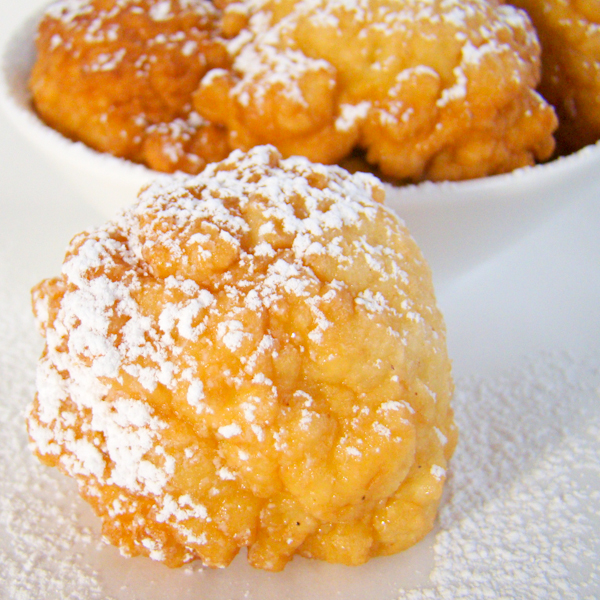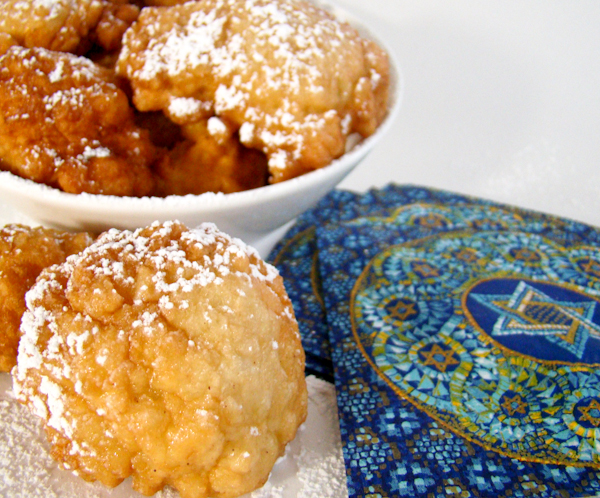
We had never heard of calas until we saw them in A Baker’s Odyssey by Greg Patent. According to A Baker’s Odyssey calas (ka-LAs) are “not too sweet rice fritters with a slightly chewy texture.” They were a “traditional delicacy for decades in New Orleans”. And, according to Jessica Harris, in her cookbook The Welcome Table “Calas seem to have been the exclusive culinary preserve of African-American cooks who peddled them in the French Market” Belles calas! Tout chaud! Beautiful rice fritters! Nice and hot!
During Hanukkah we make these delicious rice fritters as an alternative to the deep fried sufganiyot, round, ball shaped jelly donuts that are the traditional sweet of Hanukkah. Our family does not really enjoy the sufganiyot, but in keeping with the tradition of frying foods we are completely happy to deep fry calas to celebrate the miracle that occurred at the rededication of a Jewish Temple.
According to tradition as recorded in the Talmud, at the time of the rededication of a Jewish temple that was destroyed by the Greeks and then reclaimed by the Jews, there was very little oil left that had not been defiled by the Greeks. Oil was needed for the menorah (candelabrum) in the Temple, which was supposed to burn throughout the night every night.
There was only enough oil to burn for one day, yet miraculously, it burned for eight days, the time needed to prepare a fresh supply of oil for the menorah. An eight day festival was declared to commemorate this miracle. We know this festival as Hanukkah.

Calas
Ingredients
2 ¼ cups water
¾ cup long grain white rice
3 ½ tsp active dry yeast (1 ½ packages)
½ cup warm (115 degrees)water
4 large eggs, beaten
6 tbs granulated sugar
¾ tsp nutmeg
¾ tsp salt
2 cups flour
Vegetable oil for deep frying
Powdered sugar for dusting
Directions
1. The night before (or at least 6-8 hours prior to) making the calas, put the rice into a small, heavy saucepan, add the water and bring to a boil over medium high heat. Stir once or twice with a fork, cover the pan, reduce heat to very low and cook for 25 to 30 minutes, without disturbing the rice, until it is very tender and the water is absorbed.
2. Scrape the rice into a large bowl and mash it with the back of a wooden spoon or spatula to a mushy consistency. Let cool slightly.
3. In a small bowl, sprinkle the yeast over the warm water and give it a stir. Let stand in a warm spot, until the yeast is dissolved, about 10 minutes. (You can do this as the rice cooks, keeping the bowl with yeast nearby the stovetop, but not on it.)
4. When the rice is lukewarm throughout, add the yeast and beat with a wooden spoon for 2 minutes. Place a damp towel over the bowl and leave the rice at room temperature overnight or at least 6 to 8 hours.
5. The next morning, stir the beaten eggs into the rice mixture. Then, add the sugar, nutmeg and salt. Gradually stir in the flour. Cover the bowl with a damp cloth, place the bowl in a warm spot and let the batter rise for 30 minutes (or a bit longer). The batter should be bubbly.
6. When batter is almost ready pour 3 inches of oil into a large, heavy post. Clamp a deep-fry thermometer to the side of the pot, or use a digital thermometer. (If you do not have a thermometer, make sure to let the oil get very hot by putting a small dab of batter into the oil. If the batter begins to bubble and cook, the oil is ready.) Bring the oil to 375 degrees over a medium to medium-high heat. Line a large baking sheet with several layers of paper towels.
7. Use two soupspoons to drop the batter into the oil, one spoon to scrape the batter off the other spoon. Make sure you use a well-rounded soupspoon full of batter.
8. Fry the calas for 5-6 minutes or until well browned. Remover them with a slotted spoon and set them on the paper towels to drain, but do not leave them there too long as they will get soggy. Remove the calas from the paper towel and place on a serving platter.
9. Let the calas cool for a bit and then dust generously with powdered sugar. Serve immediately as they are best when freshly made.
 We had never heard of calas until we saw them in A Baker’s Odyssey by Greg Patent. According to A Baker’s Odyssey calas (ka-LAs) are “not too sweet rice fritters with a slightly chewy texture.” They were a “traditional delicacy for decades in New Orleans”. And, according to Jessica Harris, in her cookbook The Welcome Table “Calas seem to have been the exclusive culinary preserve of African-American cooks who peddled them in the French Market” Belles calas! Tout chaud! Beautiful rice fritters! Nice and hot!
During Hanukkah we make these delicious rice fritters as an alternative to the deep fried sufganiyot, round, ball shaped jelly donuts that are the traditional sweet of Hanukkah. Our family does not really enjoy the sufganiyot, but in keeping with the tradition of frying foods we are completely happy to deep fry calas to celebrate the miracle that occurred at the rededication of a Jewish Temple.
According to tradition as recorded in the Talmud, at the time of the rededication of a Jewish temple that was destroyed by the Greeks and then reclaimed by the Jews, there was very little oil left that had not been defiled by the Greeks. Oil was needed for the menorah (candelabrum) in the Temple, which was supposed to burn throughout the night every night.
There was only enough oil to burn for one day, yet miraculously, it burned for eight days, the time needed to prepare a fresh supply of oil for the menorah. An eight day festival was declared to commemorate this miracle. We know this festival as Hanukkah.
We had never heard of calas until we saw them in A Baker’s Odyssey by Greg Patent. According to A Baker’s Odyssey calas (ka-LAs) are “not too sweet rice fritters with a slightly chewy texture.” They were a “traditional delicacy for decades in New Orleans”. And, according to Jessica Harris, in her cookbook The Welcome Table “Calas seem to have been the exclusive culinary preserve of African-American cooks who peddled them in the French Market” Belles calas! Tout chaud! Beautiful rice fritters! Nice and hot!
During Hanukkah we make these delicious rice fritters as an alternative to the deep fried sufganiyot, round, ball shaped jelly donuts that are the traditional sweet of Hanukkah. Our family does not really enjoy the sufganiyot, but in keeping with the tradition of frying foods we are completely happy to deep fry calas to celebrate the miracle that occurred at the rededication of a Jewish Temple.
According to tradition as recorded in the Talmud, at the time of the rededication of a Jewish temple that was destroyed by the Greeks and then reclaimed by the Jews, there was very little oil left that had not been defiled by the Greeks. Oil was needed for the menorah (candelabrum) in the Temple, which was supposed to burn throughout the night every night.
There was only enough oil to burn for one day, yet miraculously, it burned for eight days, the time needed to prepare a fresh supply of oil for the menorah. An eight day festival was declared to commemorate this miracle. We know this festival as Hanukkah.








myfudo
December 23, 2011 at 8:42 am //
Have a Happy Christmas & Merry New Year
Kiri W.
December 25, 2011 at 6:25 pm //
Looks wonderful! I’ve never had anything similar, but I’d love to try.